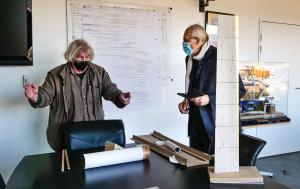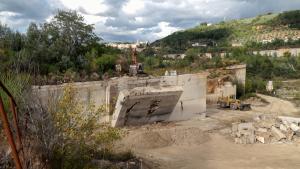Sculptor Jean-Paul Philippe presents his "monument to fusion"
Just back from a trip to the Italian village of Asciano, where he oversaw the selection of stone for Résonances, French sculptor Jean-Paul Philippe was at ITER this week to present a small-scale model of his creation.
It will stand in the village of La Roque d'Anthéron, a monumental sculpture in stone that resonates with another work by the artist in the Italian town of Asciano, and yet is resolutely turned toward ITER. A tall pillar built from seven stone blocks, each one associated with one of the ITER Members. Gold-covered angles, designed to reflect sunlight toward the ITER machine on certain symbolic dates throughout the year. A location selected to place it directly along the trajectory of ITER component convoys, as they make their way from the Mediterranean Sea to the ITER site.
The project is independent financially from the ITER Organization, but has the support of a number of staff, including ITER Director-General Bernard Bigot who is serving as the first president of the Résonances endowment fund. "The Résonances monument will have symbolic references to fusion, ITER, and the energy of Sun and stars; it will also highlight the large international collaborative nature of the ITER project, with a stone for each of the seven ITER Members. In this way, it creates an important "resonance" between Art and Science..."
The monument is in the early stages of creation. Jean-Paul Philippe travelled to the travertine quarry in Asciano to choose the stone blocks in October and to plan for their engraving. And last week, he presented a small-scale model to the ITER Director-General and discussed some of the finer details of the nine-metre-tall sculpture planned in La Roque d'Anthéron, as well as of a smaller replica that will be installed at one of the entrances to the ITER site.
If all goes according to plan the elements of the artwork, already shaped and assembled at the artist's studio situated in Siena, Italy, will be transported in June 2022 to the commune of La Roque d'Anthéron for assembly.



